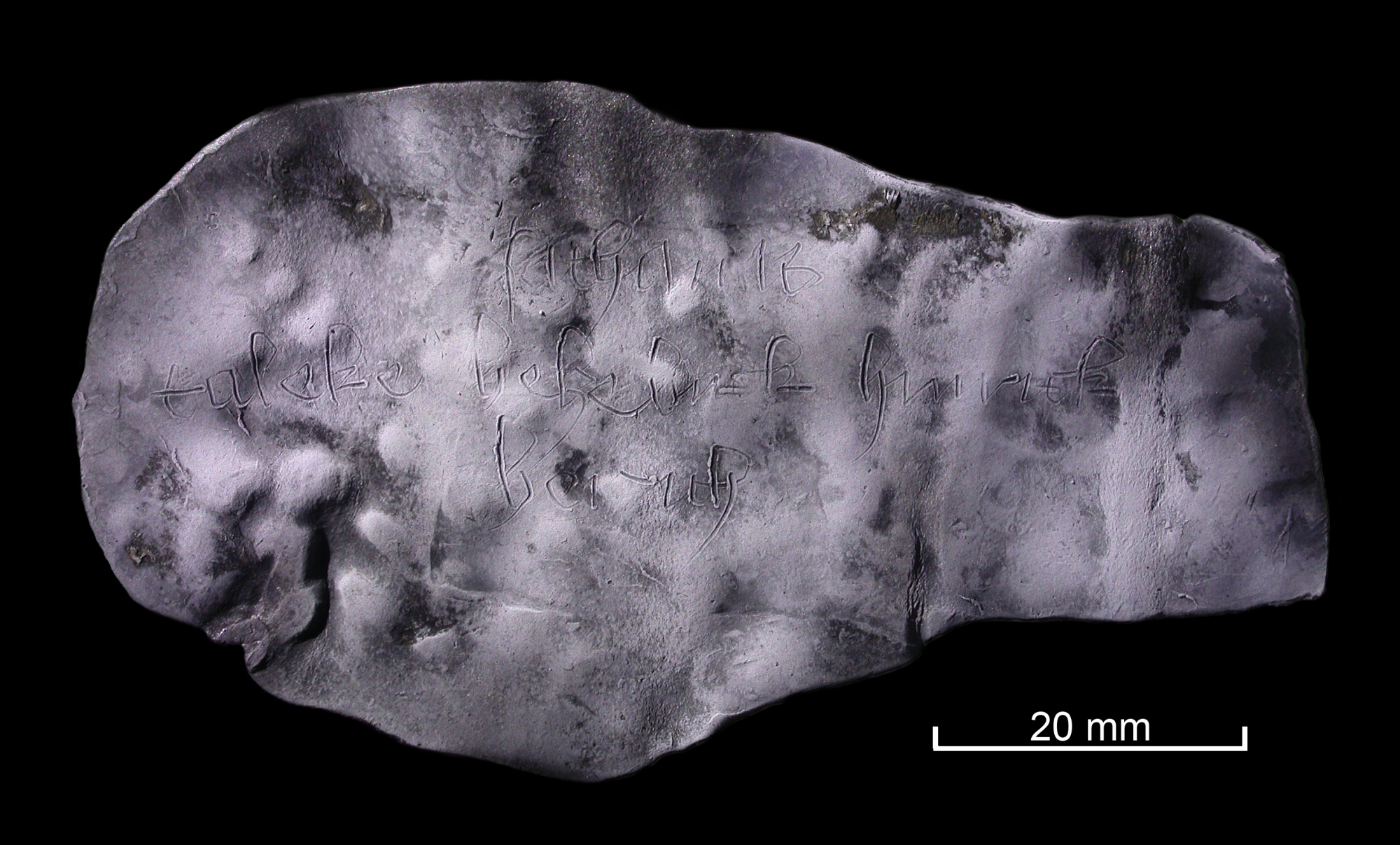Amid the decline of modern society, you might channel your anger or indignation toward a nemesis, or even a rando who slighted you, through some diluted mechanism such as a subtweet or a vanishing voice memo. Such outlets may offer relief but it is fleeting, glancing off the object of your fury or going unnoticed by them entirely. Thousands of years ago, people developed an easier, more existentially effective outlet for this kind of rage: the curse tablet.
The curse tablet is exactly what it sounds like—a tablet upon which someone has etched a curse. These curses varied in extremity. The ancient Greeks had a scorched-earth kind of curse that asked a god to destroy someone and their entire household, according to an interview with Christopher A. Faraone, a professor of classics at the University of Chicago. Most curses did not rise to this level and instead set their sights on pettier grievances. Many curse tablets asked the gods to "bind" their target to ensure they would fail at a particular task. You might curse someone who was set to testify against you, or wish for someone's attempted seduction to fail. As one of the spicier, gossip-laden ancient objects that archaeologists unearth, curse tablets occasionally make the news, and December has been a particularly hot month for them. Here's a recap!
The Very Real, Totally Not Imagined Mount Ebal Curse Tablet
The first curse tablet we'll be discussing today is called the Mount Ebal Tablet, and the main guy we need to know about is Scott Stripling, who is the director of excavations for an evangelical organization called Associates for Biblical Research that is "dedicated to demonstrating the historical reliability of the Bible." (The organization, based in Pennsylvania, has also derided "the economic malfeasance of the federal government" and claimed "marriage, family, and the individual are all under relentless assault" in two separate Christmas-oriented donation requests.)
According to Stripling, his team found the tablet while sifting through dumped material left over from a 1980s archaeological excavation at Mount Ebal, one of the highest peaks in the West Bank. The tablet was a sheet of lead folded in half, slightly bigger than a Starburst candy. He announced the find in March 2022 at a conference in Houston, claiming the tablet contained 48 letters that read: “Cursed, cursed, cursed – cursed by the God YHW./ You will die cursed./ Cursed you will surely die./ Cursed by YHW – cursed, cursed, cursed.” Stripling claimed the tablet dated to around 1200 B.C.E. or earlier and that this inscription represented the earliest-known Hebrew text and the first example of the Hebrew name of God. Sounds like a pretty big find! Would you like to see the letters allegedly inscribed on such a tablet?
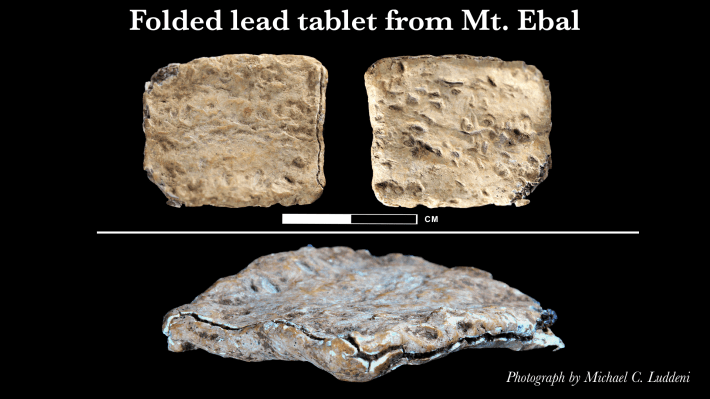
Do those indentations look like letters (of any language) to you? Or do they look like the random dings a scrap of metal might accumulate over the course of thousands of years? If you'd like to zoom in more to examine it more closely, too bad! This is the highest-resolution image the archaeologists released.
As you might imagine, Stripling's announcement was met with skepticism from the scientific community, many of whom declined to comment on such claims until the curse tablet was officially published in a scientific journal. In general, it's a frowned-upon practice to announce scientific claims without an evidence-based, peer-reviewed paper to back them up. But this practice is common in the field of biblical archaeology, the archaeologist Michael Press observed. The sensational announcement was largely ignored in the U.S. with the exceptions of a few publications including Live Science and a local newspaper from Houston, where Stripling lives. But it made headlines in major Israeli publications including the Times of Israel, Haaretz, and The Jerusalem Post.
For several years, far-right Israeli ministers have weaponized archaeological heritage sites in occupied East Jerusalem and the West Bank to create a Judeo-centric story, wrote Alon Arad, an archaeologist and the executive director of the Israeli NGO Emek Shaveh, in +972 magazine. "This is the narrative used to efface Palestinian ties to heritage sites, delegitimize their claims to the land, and displace them from their homes and agricultural territories," Arad wrote.
Mount Ebal, which is located north of Nablus, between the village of a-Sira a-Shamaliya and the Balata refugee camp, is a site of particular importance to Zionists. It is is located in Area B of the West Bank, which is under Palestinian civil control. The late Israeli archaeologist Adam Zertal, who studied the site in the 1980s and dumped the dirt that Stripling would search for the tablet, argued the structure at Ebal was an altar built by Joshua as was described in the Book of Joshua, a claim that a majority of archaeologists find unsubstantiated. But identifying Mount Ebal with Joshua helps legitimate the settler claim to the West Bank, according to a report from Emek Shaveh.
Fast forward to May 2023, when Stripling and his team finally published a paper with photos of the tablet in a scientific journal. They did not publish it in a philological journal or a biblical studies journal or a history journal or a Jewish studies journal—journals actually relevant to a discovery like this, Robert Cargill, a classics professor at the University of Iowa, explained in a video. Instead, Stripling and colleagues published the tablet in a "very niche technical journal" called Heritage Science, Cargill explained. This paper included (finally!) scanned images of the tablet...
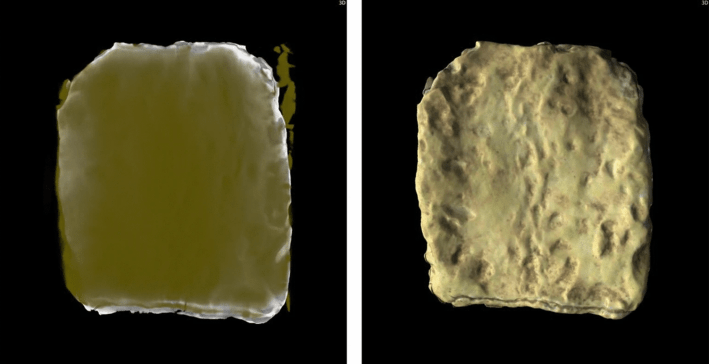
...accompanied by drawings of the alleged inscriptions.
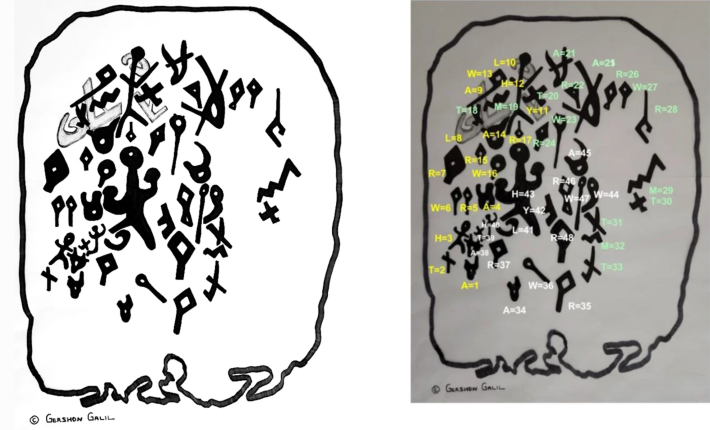
As you can see above, the letters are all different sizes and orientations, and and have no clear reading direction, as the historian Christopher W. Jones pointed out in a tweet thread.
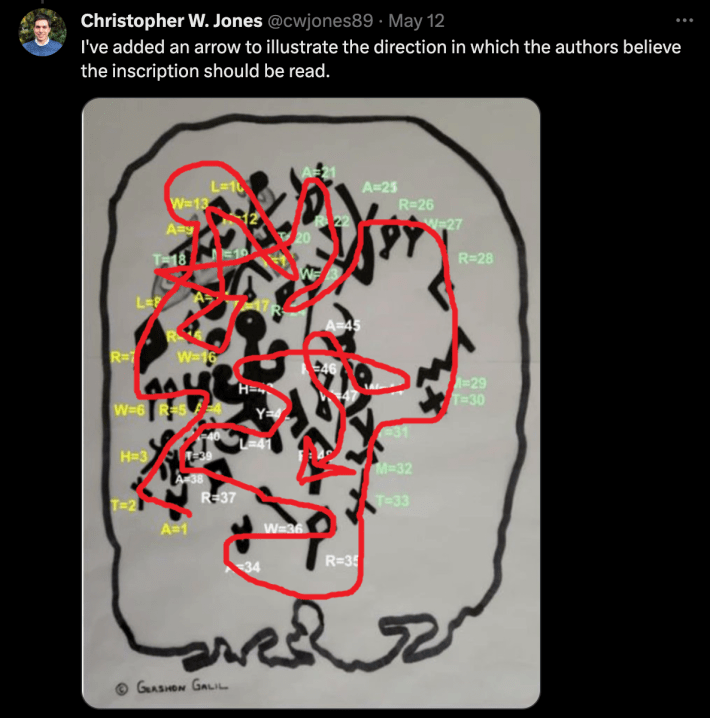
The drawings are the brainchild of author Gershon Galil, a professor emeritus at the University of Haifa, who has a history of "successfully deciphering" ancient inscriptions and announcing those inscriptions in mass media without offering any high-resolution images, just his own drawings or incredibly low-resolution images. In 2022, Galil claimed to have deciphered a 3,500-year-old curse tablet that he said was used in a "voodoo ceremony."
In the paper, Stripling and co-authors state the artifact was found in Israel and the excavation "occurred under the auspices of the Israel Antiquities Authority." But Mount Ebal is under Palestinian civil control, meaning the Palestinian Authority would be in charge of issuing excavation licenses in the area, suggesting the archaeologists violated multiple laws, Haaretz reported. In July, the nonprofit Emek Shaveh published a report about an illegal excavation on Mount Ebal that took place in June, involving "volunteers from the Associates for Biblical Research."
Finally, earlier this month, the Israel Exploration Journal published three new studies thoroughly eviscerating Stripling's conclusions, according to Haaretz. The first study determined that the supposed inscriptions were actually the "random scratches, striations, pitting, and indentions" that happen when something is in the ground for a long, long time. Another study identified the lead as originating from a mine in Greece but cautioned that the mine was active over various time periods and couldn't be used as a method of dating. And the last study suggests the object is simply a lead fishing weight.
What have we learned from all of this, a story that I pitched to Barry thinking it would be a fun example of an "oopsies" in science? Archaeology, like any science, can be misused or interpreted in pursuit of human biases and nationalist or religious agendas. Never trust a sensationalist scientific claim that is accompanied by a single, blurry photo or is announced first in the media before making its way through the peer-review process. And if you're going to fabricate a curse on a curse tablet, make up a better curse!
Finally, A Real Freaking Curse Tablet
After such a depressing saga, you might be craving a real curse tablet. Well have I got just the tablet for you! During excavations at a construction site, archaeologists have just unearthed a small lead scroll beneath a latrine in the German city of Rostock, according to the city's press release. They released a high-resolution image of the curse tablet.
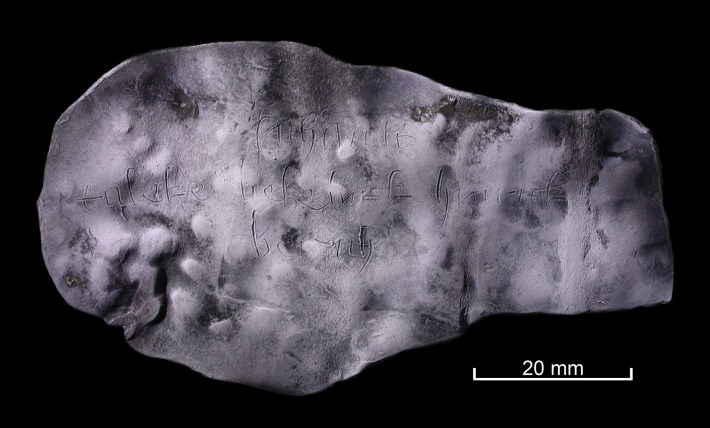
That's what I'm talking about! Even I, a casual fan of curse tablets, can see clearly that this is a curse tablet. And its location at the bottom of a latrine adds credence to this identity, as curse tablets were supposed to be placed somewhere very, very hard to find, lest the object of the curse discover it and meddle with the magic.
This particular curse tablet, which dates back to the 15th century, was inscribed with the words: “sathanas taleke belzebuk hinrik berith.” The curse targets a woman named Taleke and a man named Hinrik and appears to be summoning demons Satan, Beelzebub, and Berith against poor Taleke and Hinrik. The archaeologists speculated the curse could be an attempt to break up a romance between Taleke and Hinrik. How spicy! I can't help but speculate. Did Taleke and Hinrik have a forbidden romance, perhaps cheating on partners with each other? Did an unrequited suitor of either Taleke and Hinrik (or both!) wish to dismantle their union for a shot at love with one of the pair? Were Taleke and Hinrik simply two ruffians raising a ruckus in Rostock? We may never know. But I hope whoever buried this curse tablet, after scrawling their curse into the slab of lead, felt a great lightness after the fact, their burden of hatred lifted and their rage quenched more wholly than any subtweet ever could.
CORRECTION: An earlier version of this story misstated Christopher A. Faraone’s affiliation.
